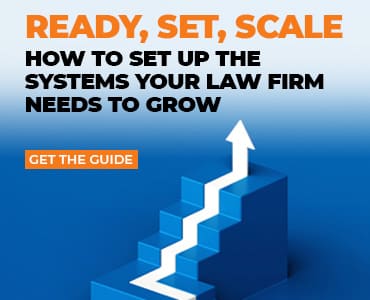As a small law firm owner, you know the stress of checking your account balances — and realizing that the big payment you were expecting has failed to materialize. Again. The 2023 Clio Legal Trends Report includes a new metric to monitor law firm cash flow so you can plan for the ups and the downs.

Table of contents
Every lawyer has that one problem client keeping them up at night. They suck up more time than 10 clients combined, grouse about your rates, never pay when they say they will, and ultimately threaten your firm’s growth.
Of course, you can always fire that client. But if collection problems are more widespread at your firm, which they probably are, you have a cash flow problem, not just a client problem. And without reliable cash flow, your firm could be in trouble.
Lockup Shows You How Much Cash You Don’t Have
In addition to tracking billing, utilization, realization, and collection rates, Clio’s 2023 Legal Trends Report has a new metric to assess cash flow: Lockup.
Lockup measures how quickly — or slowly — businesses get paid after sending invoices to clients. More specifically, firms can use it to track cash that is locked up because work is unbilled (realization) or because of bills that are unpaid (collections). The higher the total lockup percentage, the slower your cash flow — and the more your firm is at risk.
Why is this metric so important? According to the Legal Trends Report:
“While realization and collection rates give insight into how much revenue firms earn overall, they don’t give any insight into the period — or latency — in which they collect that revenue. A law firm could bill and collect a significant amount of revenue. However, if they aren’t able to do this in a timely and efficient manner, their business could actually be suffering in terms of its net cash flow.”
How Do You Measure Lockup?
Before diving into lockup, here’s a refresher on realization and collection rates:
- Realization rate is the percentage of billable work that gets invoiced. Divide the number of billable hours invoiced by the number of hours worked.
- Collection rate is the percentage of invoiced work that gets paid. Divide the number of hours collected by the number of hours invoiced.
And here are the formulas for calculating lockup:
- Realization lockup = (work in progress ÷ previous fiscal year’s collections) × 365 days
- Collection lockup = (accounts receivable ÷ previous fiscal year’s collections) × 365 days
- Total lockup = realization lockup + collection lockup
Decreases in lockup mean more cash on hand to cover expenses or fund growth — from staffing to technology to marketing. On the flip side, an increase means more of your cash is unbilled or uncollected.
How Can You Get Your Hands on More Cash?
According to the Legal Trends Report, since 2016, collection rates have risen from 86% to a high of 90% in 2021 and 89% in 2022. Collection rates are expected to stay at 89% through 2023, though they could drop a point or two. So, while firms have made modest gains, there is plenty of room for improvement.
Here are a few ideas.
Track Your KPIs
Keep on top of key performance metrics so you can avoid — or better manage — a cashflow crunch. Also, be sure to review standard reports, like monthly accounts receivables and profit and loss statements, for irregularities.
Get the Basics Right
Make sure your invoice and all communications clearly state what should be paid, when it should be paid, how it should be paid, and who to call with questions.
Send the Invoice
One of the most stunning findings in the Legal Trends Report was that 15% of the client respondents who had hired a lawyer at some point said they didn’t receive a bill at all. And, of clients who did receive a bill, 28% said it was a noticeably long time after their lawyer did the work. Even stranger, more than 54% said they received their invoice in person, likely at a final meeting or closing.
Upgrade to Electronic Billing
The faster you bill, the faster you get paid. Yet, according to the Trends Report, 39% of firms send bills via the U.S. Postal Service. Most modern practice management platforms have electronic billing features that significantly reduce the time it takes to get invoices, statements and follow-ups to clients.
Accept Online Payments and Credit Cards
Whether your system is set up to accept online payments via credit card or you allow clients to send payments directly to your bank, the easier it is to pay you, the faster you will get paid. According to the Trends Report’s survey of consumers, “Paying by credit card was the most preferred option for paying a lawyer, accounting for almost half of all respondents across all age groups. Only one in five wanted to pay by check, and even fewer by cash.”
Refine Your SOPs
Sadly, tracking time, billing, payments and collections is not a “set it and forget it” proposition. Periodically review every step in the process, looking for roadblocks, duplication, items to automate and ways to make improvements. Write down everything to create your new, improved SOPs. Small incremental improvements can have a supersized impact on cash flow.
Automate It
Even lawyers who prefer to hand their bills to clients can automate subsequent communications. Be sure to note communication preferences before sending a follow-up and use more than one method to communicate if the client is slow to pay. If you post your invoices to a client portal or app, consider that clients probably aren’t checking them as often as you’d think — especially once the matter is closed. Send an email alert or text with a link to check-in to pay their bill.
Think Outside the Box
Explore alternative billing arrangements, collect advance fees (retainers), bill in smaller amounts as you go instead of one large lump sum, and keep up with new features in your practice management and billing platform.
For in-depth information on applying these KPIs and insights on law firm performance, download the latest Clio Legal Trends Report here.
Getting Paid What You Are Owed
You’ll find more good ideas here on Attorney at Work to help you get paid for your services — and charge what you are worth.
- Going After Non-Paying Clients: A Q&A With a Collections Attorney
- Tackling Law Firms’ Biggest Collections Problems
- It’s Your Money: Steps to Improve Collections
- Don’t Be Afraid to Raise Your Legal Fees
- Getting the Fee You Deserve
Image © iStockPhoto.com.

Sign up for Attorney at Work’s daily practice tips newsletter here and subscribe to our podcast, Attorney at Work Today.
















